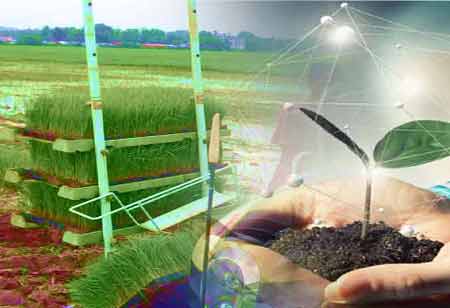Thank you for Subscribing to Agri Business Review Weekly Brief
Advantages of Biochar
Biochar can be described as the carbonaceous byproduct of pyrolysis (heat treatment of biomass in an oxygen-limited environment) and the charred byproduct when applied as a soil amendment.

By
Agri Business Review | Tuesday, February 14, 2023
Stay ahead of the industry with exclusive feature stories on the top companies, expert insights and the latest news delivered straight to your inbox. Subscribe today.
Biochar is a carbonaceous product produced from biomass pyrolysis in an oxygen-limited environment. The technique is common for carbon sequestration.
FREMONT, CA: Biochar can be described as the carbonaceous byproduct of pyrolysis (heat treatment of biomass in an oxygen-limited environment) and the charred byproduct when applied as a soil amendment. Pyrolysis is the non-oxygen-dependent thermal depolymerization of biomass at extreme temperatures. Syngas, bio-oil, and char are the end products of pyrolysis. The char, also known as biochar, can be used as an energy source and soil supplement. It can be created from various organic materials, such as paper mill sludge, forest and crop wastes, and poultry waste. Applications of biochar as a sustainable technology that improves worn and deteriorated soils are gaining popularity. It improves the soil's physical, chemical, and biological qualities, enhancing plant growth and development. Its resistance to microbial degradation ensures a lasting improvement in soil fertility. In addition, it enhances the saturated hydraulic conductivity of rice field topsoil and xylem sap, resulting in increased crop yields and improved response to N and NP chemical fertilizer treatments. They contain a limited amount of heavy metals and hazardous elements, such as As, Cd, Pb, and polycyclic aromatic hydrocarbons; therefore, the risk of exposure is minimal. They have the potential to increase soil fertility, agricultural yield, nutrient, and water usage efficiency, and reduce N2O emissions. Long-term carbon storage in the soil can decrease the rising levels of atmospheric CO2. In this light, biochar has become a feasible solution for soil carbon sequestration.
Relationship between Biochar and Soil
It is recognized that biochar can sequester carbon and improve soil functioning. After its assimilation into the soil, the interaction between biochar, soils, microorganisms, and plant roots proceeds rapidly. The interactions are influenced by feedstock composition, namely the mineral fraction's overall percentage and specific composition; pyrolysis process parameters; biochar particle size and delivery system; and soil characteristics and regional environmental conditions. Biochar aging begins before incorporation into soils, and after incorporation, the rate is partially regulated by soil moisture and temperature. The evolution of biochar-derived carbon can be noticed within the first two weeks following the application of biochar amendment and diminishes dramatically with time. Water plays a crucial role in mineral weathering processes such as hydrolysis, dissolution, carbonation and decarbonization, hydration, and redox reactions. The rate of these reactions relies on the biochar type, the nature of the reactions, and the pedoclimatic conditions. The first response among all interactions is the dissolution and leaching of soluble salts (e.g., K and Na carbonates and oxides) present in the biochar. The dissolution causes the pH of the water film surrounding the biochar particles to rise. Biochar produced from biomass remains thermodynamically unstable in the oxidative state of the majority of surface soils. Low-temperature biochar has a significant amount of non-aromatic C, making it more sensitive to microbial attack and subsequent oxidation than high-temperature biochar. Despite the remarkable stability of aromatic C, it possesses redox activity and operates as a reducing agent, O2 being the most prevalent electron-accepting species. The electron-donating capabilities of a region with a high concentration of -electrons accelerated the abiotic reaction and commenced biochar oxidation. Depending on the pyrolysis process, the amount of free radicals in biochar enhances its sensitivity toward oxidation. Biochar particles can have both acidic and basic characteristics and are highly influenced by the moisture condition and the electrostatic retention of ions on the surface. They often coexist; however, as the biochar particle weathers, the concentration of primary sites drops due to oxidative reactions. Higher mineral content biochar interacts with organic matter and clay mineral surfaces depending on the type of clay (2:1, 1:1), distribution of functional groups on the clays (siloxane, OH), and organic matter (COOH, C=O, C–O, CN), polarity of these compounds, and composition and concentration of cations and anions in solution. In addition, biochar has intricate interactions with plant roots and microbes.
Along with root hairs, biochar interacts with soils. Once the root system reaches the biochar particle, the root hairs can enter the water-filled macropores of the particle, and organic substances (including low- and high-molecular-weight compounds such as free exudates and mucilage) can be absorbed by biochar surfaces. The soil-dwelling fauna (such as earthworms, termites, larvae, and other insects) consume or inhabit biochar by fragmenting or covering it with organic substances. Bioturbation by earthworms is crucial for biologically mixing biochar with the soil profile—the downward flow of biochar within the soil profile where low microbial activity increases with time.





